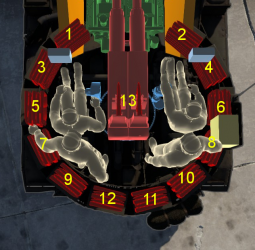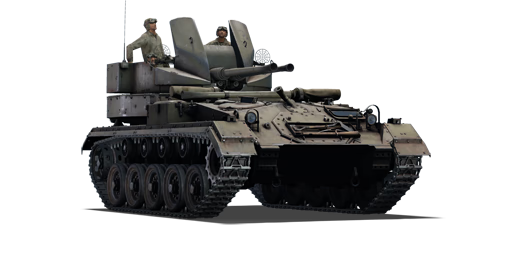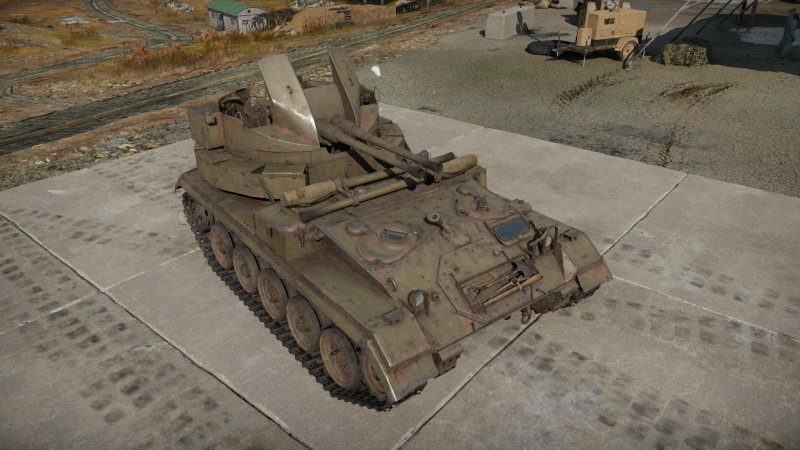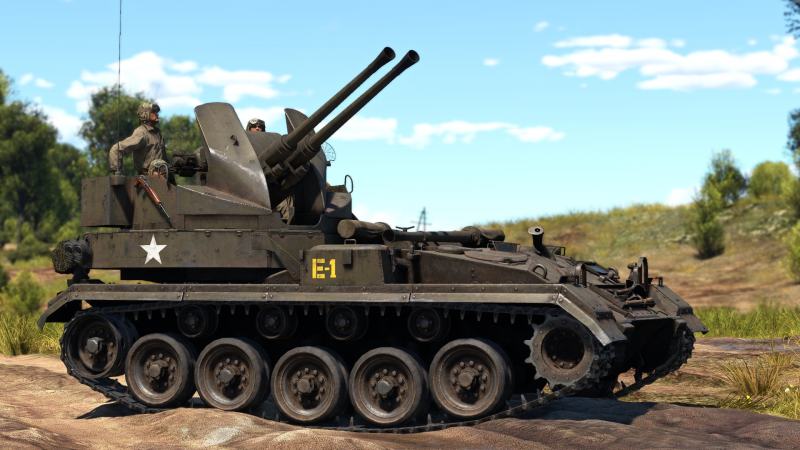M19A1
| This page is about the American SPAA M19A1. For the Japanese variant, see M19A1 (Japan). |
Contents
Description
The Twin Gun Motor Carriage M19A1 is a rank III American self-propelled anti-aircraft (SPAA) gun with a battle rating of 4.7 (AB) and 4.0 (RB/SB). It was one of the first vehicles to be released with the US ground forces in Update 1.45 "Steel Generals". Armed with dual-mounted 40 mm Bofors guns, the M19A1 provides a substantial firepower upgrade over the standard .50 cal machine guns and 37 mm autocannon used in its predecessors M16 MGMC and M15A1 CGMC.
As an SPAA, stay behind and close to your teammates and outside of your enemies' view and range while keeping a clear line of sight to the horizon for low-flying aircraft.
General info
Survivability and armour
Armour type:
- Rolled homogeneous armour (hull, turret)
| Armour | Front (Slope angle) | Sides | Rear | Roof |
|---|---|---|---|---|
| Hull | 12.7 mm (59°) Upper glacis 12.7 mm (45°) Lower glacis |
12.7 mm (11°) | 12.7 mm | 12.7 mm |
| Turret | 12.7 mm (cylindrical) Gun shield - lower part 12.7 mm (spherical) Gun shield - upper part |
8 mm (cylindrical) 8 + 12.7 mm (cylindrical) Turret base |
8 mm (cylindrical) 8 + 12.7 mm (cylindrical) Turret base |
Notes:
- Suspension wheels are 10 mm thick while tracks are 15 mm thick.
The M19A1 is so lightly armoured that it is very vulnerable to nearby ammorack detonations, bomb blasts and even heavy MG fire can reliably penetrate the vehicle from beyond 1,000 m. As the M19A1 has an open-topped turret, gun servants are also very exposed to MG fire, artillery strikes and plane strafings.
Mobility
| Game Mode | Max Speed (km/h) | Weight (tons) | Engine power (horsepower) | Power-to-weight ratio (hp/ton) | |||
|---|---|---|---|---|---|---|---|
| Forward | Reverse | Stock | Upgraded | Stock | Upgraded | ||
| Arcade | 62 | 26 | 18.7 | 420 | 565 | 22.46 | 30.21 |
| Realistic | 57 | 24 | 262 | 296 | 14.01 | 15.83 | |
As a light vehicle, the M19A1 is agile. While it has a high top speed, the acceleration is quite slow: expect a cruise speed around 40 km/h instead. The reverse speed is very high, allowing you to pull out of dangerous situations quickly. The lack of neutral steering makes turning on the spot slow (3 km/h): make sure to build a little speed before turning and you'll turn faster (7 km/h). If you need to quickly turn your hull on the spot towards flanking enemies, privilege the reverse gear (-6 km/h).
The offroad mobility is good: the M19A1 reaches 17 km/h when fording, 19 km/h when driving uphill with some speed built-up and a mere 12 km/h uphill from a stop start. The wide tracks combined to the light weight of the vehicle grant the M19A1 a good mobility on hard (solid ground, roads) and soft terrain (mud, snow, sand). Light obstacles (fences and bushes) are not a problem but medium to large obstacles (posts, trees, concrete blocks and parked vehicles) will reduce your mobility: avoid them.
Modifications and economy
Armaments
Main armament
| 40 mm Dual Automatic Gun M2 (x2) | Turret rotation speed (°/s) | Reloading rate (seconds) | ||||||||||||
|---|---|---|---|---|---|---|---|---|---|---|---|---|---|---|
| Mode | Capacity (Belt) | Fire rate | Vertical | Horizontal | Stabilizer | Stock | Upgraded | Full | Expert | Aced | Stock | Full | Expert | Aced |
| Arcade | 352 (8) | 120 | -5°/+85° | ±180° | N/A | 35.2 | 48.8 | 59.2 | 65.5 | 69.7 | 0.65 | 0.58 | 0.53 | 0.50 |
| Realistic | 23.8 | 28.0 | 34.0 | 37.6 | 40.0 | |||||||||
The 40 mm gun stays reliably accurate until 1,000 m distance. Beyond 1,500 m the loss of accuracy becomes a real handicap. The shortness of the gun is mitigated by the high rate of fire and the fact that targeted aircraft are bigger than an average ground vehicle. Your ideal engagement window is between 1,000 and 1,500 m for aircraft. The high muzzle velocity of your shells grants you pretty flat firing trajectories and thus helps fire at fast-moving targets from a distance. As your shells weigh the same, your different belts offer the same firing arc.
The turret traverse speed is very high, allowing you to track any aircraft flying right by you. The gun elevation is also very good, almost allowing vertical fire. The depression angle is poor but not often used. The recoil is minimal and barely impacts your targeting. The reload time between clips is very short: under 1 second. While lacking a stabilizer, the M19 still can reliably fire on the move at targets under 700 m distance.
The gun overheats after in 20 seconds of uninterrupted fire and is forced into a cooldown phase of 10 seconds during which you can't shoot. To keep the gun from overheating, privilege firing by bursts instead of continuous fire with small pauses between shots. The overheating is displayed in-game by 4 red quadrants around your sight gradually filling up as you gun temperature rises. Always keep it from reaching the 3rd quadrant.
Ammunition
- Default: AP-T · FI-T* - The belt composition means that 50% of the shells (FI-T*) are useless against tanks. However, this belt is reliable against open-topped or lightly armoured targets like SPAA vehicles as well as against planes.
- Mk.II: FI-T* - This belt does little damage against armoured targets and should be used especially against aircraft or open-topped vehicles. The high-explosive filler is deadly to crew members.
- M81A1: AP-T - This belt offers decent damage against lightly armoured tanks, especially at close range. While the damage effects post-penetration can be quite poor, the rapid fire from the autocannon can remedy this problem by following up quickly with another penetrating shot. In close combat, these shells should be used against modules and crew member to make the most of each shell.
| Penetration statistics | |||||||
|---|---|---|---|---|---|---|---|
| Ammunition | Type of warhead |
Penetration @ 0° Angle of Attack (mm) | |||||
| 10 m | 100 m | 500 m | 1,000 m | 1,500 m | 2,000 m | ||
| Mk.II | FI-T* | 9 | 8 | 7 | 6 | 5 | 4 |
| M81A1 | AP-T | 72 | 69 | 58 | 46 | 37 | 29 |
| Shell details | ||||||||||||
|---|---|---|---|---|---|---|---|---|---|---|---|---|
| Ammunition | Type of warhead |
Velocity (m/s) |
Projectile mass (kg) |
Fuse delay (m) |
Fuse sensitivity (mm) |
Explosive mass (TNT equivalent) (g) |
Ricochet | |||||
| 0% | 50% | 100% | ||||||||||
| Mk.II | FI-T* | 874 | 0.83 | 0.1 | 0.1 | 63 | 79° | 80° | 81° | |||
| M81A1 | AP-T | 875 | 0.88 | - | - | - | 47° | 60° | 65° | |||
Ammo racks

| Full ammo |
1st rack empty |
2nd rack empty |
3rd rack empty |
4th rack empty |
5th rack empty |
6th rack empty |
7th rack empty |
|---|---|---|---|---|---|---|---|
| 44 | 40 (+4) | 36 (+8) | 32 (+12) | 30 (+14) | 26 (+18) | 22 (+22) | 18 (+36) |
| 8th rack empty |
9th rack empty |
10th rack empty |
11th rack empty |
12th rack empty |
13th rack empty |
Visual discrepancy |
|
| 16 (+28) | 12 (+32) | 8 (+36) | 4 (+40) | 2 (+42) | 0 (+44) | Yes |
Notes:
- Ammunition is modelled as 44 clips of 8 rounds
- The visual discrepancy concerns the total number of rounds: 312 rounds are modeled but you can pack 352 rounds.
Usage in battles
With the Dual 40 mm Bofors the M19 has an excellent weapon against bombers and armoured attackers. The ammo is limited though, so reserve the fire for certain hits. Against fighters, the same tactic should be applied.
Due to its poor rate of fire and therefore fire density, it's best to concentrate fire at a spot the plane is expected to fly towards whilst leading to compensate, bursts should be short and constant adjustments should be made. Thanks to its large calibre and continuous fire, the M19A1 can be used to take out long range bombers at high altitudes .50 cal and 20 mm rounds may fail to reach.
Compared to certain other SPAAs (ZSU-37, Wirbelwind, M13 MGMC, etc.), the M19 cannot be used as effectively in an anti-vehicle role, so stay behind your allies and watch the skies for enemy aircraft. If contact with ground targets is inevitable however, aiming for a targets' cannon barrel or tracks is a valid option. If flanking is available, take the opportunity and load some shells into their sides or rear. However be very careful, your crew members are exposed to machine gun fire and can easily be knocked out. This is a problem especially if it's coming from enemy aircraft, as they can also easily kill your crew. So take caution if using the M19 in an anti-vehicle role
Pros and cons
Pros:
- Good mobility
- Powerful 40 mm HE shells, can decimate/critically damage aircraft
- Reloads in 0.6 seconds, quasi-continuous fire
- High ammo count
Cons:
- Open-topped, exposing loaders and gunners
- Compared to other SPAA at the same rank, poor anti-vehicle performance
- Little armour
- Decreased mobility off-road
- Exposed ammo rack
- Weak anti-air firepower due poor rate of fire
- Gun overheats when firing continuously
History
Development
The development of this vehicle began from the T65 project. The T65 was classified as the 40 mm Gun Motor Carriage T65 and was based off the chassis of the M5 Stuart as requested by US Army Armored Force for a light anti-aircraft vehicle. The T65 was a successful vehicle and went on for about 1,000 units produced, however, it stopped because the production line for the Stuart chassis was phased out as well. As a replacement, the Armored Force peered into the new light tank entering production, the M24 Chaffee, as the basis of their new light anti-aircraft vehicle. This project was called the T65E1 and was being developed at the same time with the M24 (still in development as the T24). The layout for the T65E1 on the new chassis was similar to the one used with Stuart's chassis, with the gun turret at the rear and engine at the middle, and only a few changes were made like changing the original vertical gun shield into an angular one.
The T65E1 was accepted in May 1944 and designated as the Twin Gun Motor Carriage M19. An order of 904 of these vehicles was sent to Cadillac, but production didn't start until August and the factory was only able to make 285 units before the war ended due to diversion in parts to creating full M24 Chaffees. An upgrade made during its production life was designated the M19A1 and had an auxiliary engine and generator to operate the 40 mm cannons in case the main engine is disabled, plus an extra compartment to hold two spare barrels for the gun should they be damaged or overheated.
Combat usage
The M19 TGMCs that were produced were sent to Europe and used by the US Army. However, by the time the M19 was available for use, the German Luftwaffe had been decimated by the Allied air superiority, thus the M19 use as an anti-aircraft gun has been diminished greatly. The M19, like its many anti-aircraft vehicle designs made before it, found great service as an assault gun, where its 40 mm twin cannons can deliver much more firepower than its predecessors with either only .50 calibre machine guns (M16 MGMC), or a 37 mm autocannon (M15 CGMC). The M19 was never exported to America's allies in the Lend-Lease Act, and not even after the war with the Military Aid Program. Despite that, the M19 still saw use in America up to the Korean War for nearly the same purposes it was given for in World War II as a ground support weapon. It was used as a defensive turret against charging North Korean and Chinese forces when they try to overrun infantry positions, to which it served with devastating effect. Its effect against enemy aircraft is dubious during the war.
When the M24 Chaffee and its chassis derivatives were finally phased out of service in 1956 for newer tanks in production, the M19 was no exception. However, the M19 40 mm turrets were removed from the chassis and was simply put onto the next light tank chassis that was to take over the role the M24 Chaffee was built for. This light tank was the M41 Walker Bulldog and the M19 turret-mounted chassis was named the M42 Duster.
| Archive of the in-game description | |
|---|---|
|
Combat experience in 1941-1942 showed that the troops needed a mobile anti-aircraft system capable of escorting mechanized columns and protecting against enemy aircraft. Development of the new vehicle began in 1942. The first prototype of the T65 self-propelled artillery piece was created using the M5A1 light tank chassis, though it was replaced during trials with the M24 light tank's more modern version. The hull's nose section was home to the transmission and the driver's compartment, in which the driver (left) and commander (right) were located. The roof of the driver's compartment had hatches and periscopes, while the engine was located in the center section. The battle compartment was in the rear section, on the roof of which was an open-air turret system mounted in the front with two electrically fired 40 mm Bofors automatic cannons. The turret was rotated using a manually operated electrohydraulic actuator. Ammunition included high-explosive and incendiary rounds, while the crew was armed with two 11.43 mm Thompson submachine guns and four 7.62 mm carbines. By September 1945 Cadillac and Masse-Harris had produced 285 (300 by other calculations) units, and by the end of 1945 they had begun to join tank divisions. They saw combat in the Korean War from 1950 to 1953. The primary goal of the M19 was to fight off land targets, something they were good at through the entire campaign, and they remained in the US army until 1956. | |
Media
- Skins
- Videos
See also
- Vehicles equipped with the same chassis
- Other vehicles of similar configuration and role
External links
- [Development] Steel Generals: M19
- [Development] Developers about the M19
- [Wikipedia] M19 Multiple Gun Motor Carriage
- [Military Factory] M19 Gun Motor Carriage (M19 Twin 40mm)
| USA anti-aircraft vehicles | |
|---|---|
| M3 Half-track derivatives | M13 MGMC · M15 CGMC · M16 MGMC |
| M24 derivative | M19A1 |
| M41 derivative | M42 |
| Radar SPAAG | M163 · M247 |
| Missile SPAA | Imp.Chaparral · LAV-AD · XM975 |






